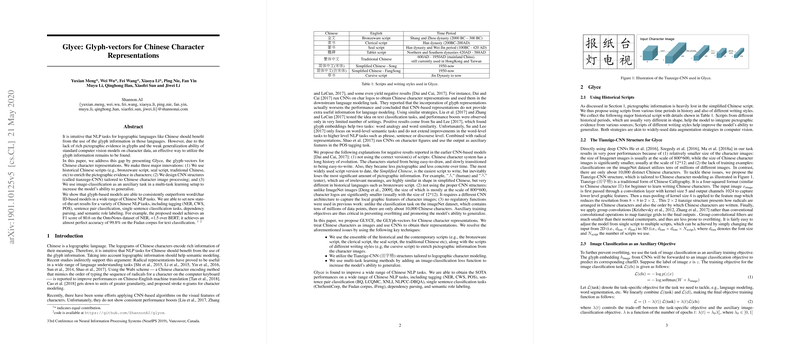Glyce: Glyph-vectors for Chinese Character Representations
The paper "Glyce: Glyph-vectors for Chinese Character Representations" presents a novel approach to incorporating glyph information into NLP tasks for Chinese, a logographic language. The research addresses the challenges of exploiting glyph information, which traditionally has seen limited success due to poor generalization of standard computer vision models and the lack of rich pictographic evidence in contemporary Chinese scripts.
Key Contributions
- Historical Scripts for Enhanced Pictographic Evidence: The authors leverage a variety of historical Chinese scripts including bronzeware, seal, clerical, and cursive scripts, alongside traditional and simplified Chinese. This strategic inclusion captures lost pictographic information, providing a rich data source for character representation.
- Tianzige-CNN Architecture: The paper introduces the Tianzige-CNN, a convolutional neural network tailored specifically for Chinese character images. This architecture addresses the distinct challenges posed by the smaller size and limited variety of Chinese character images, enhancing local feature capture and preventing overfitting.
- Auxiliary Image-Classification Objective: An image-classification task is incorporated as a regularizing function in the multi-task learning setup to improve generalization. This auxiliary task helps in enhancing the model's robustness in capturing character semantics.
Experimental Results and Implications
The Glyce model demonstrates significant improvements across a spectrum of Chinese NLP tasks:
- Named Entity Recognition (NER): On the OntoNotes dataset, Glyce surpasses BERT, achieving an F1 score of 80.6, marking a +1.5 improvement.
- Text Classification: An accuracy of 99.8% is reported on the Fudan corpus for text classification tasks.
- Word Segmentation and POS Tagging: Glyce consistently outperforms existing models by integrating character-level semantics with glyph vector information.
The research provides a robust benchmark for various tasks, including sentence pair classification, dependency parsing, and semantic role labeling, setting state-of-the-art (SOTA) results. These improvements underscore the potential of integrating glyph information to enhance the understanding of logographic languages in NLP.
Theoretical and Practical Implications
Theoretically, the integration of glyph information advances the semantic modeling framework for logographic languages, challenging the limitations of traditional character ID-based models. Practically, Glyce offers a generalizable approach that can be embedded in any deep learning system, similar to how word embeddings are utilized.
Future Directions
Considering the promising results, future research could explore:
- Extending Glyce to other logographic languages like Japanese kanji.
- Refining architectural designs and enhancing training strategies for better efficiency.
- Incorporating glyph vectors into more complex tasks such as machine translation and dialogue models.
Glyce's methodology represents a significant advancement in modeling Chinese characters and proposes a comprehensive framework applicable to other logographic systems, fostering further innovations in the field of NLP for logographic languages.
